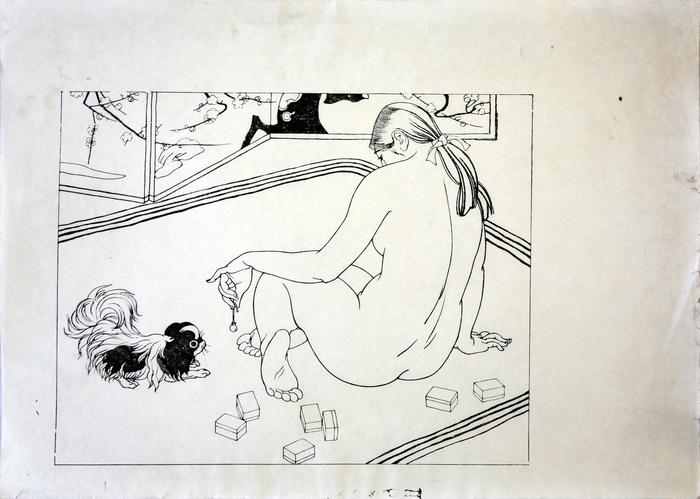Ishikawa Toraji (石川寅治) (artist 1875 – 1964)
Sound of a Bell (Suzu no Ne - 鈴の音) key block or tameshizuri-e from the series Ten Types of Female Nudes (Rajo jūsshu - 裸女十種)
1934
22.125 in x 15.75 in (Overall dimensions) black and white woodblock print
Los Angeles County Museum of Art - finished print
Honolulu Museum of Art - finished print
National Diet Library - photo in black and white of the colored print
Art Institute of Chicago - the finished print
Los Angeles County Museum of Art - the finished print
Museum für angewandte Kunst, Vienna - finished print
Harn Museum of Art Scholten Japanese Art wrote about Toraji's use of keyblock prints:
"Keyblock proofs were produced for multiple purposes: in traditional woodblock print production the black outline proofs were primarily used to actually make the color blocks- subsequently destroying the proof while carving the block. Keyblock proofs from the 18th and 19th century are relatively unusual, and often those that have survived are from obscure designs that never made into production.
But by the 20th century, collectors became more appreciative of all of the nuances of woodblock print production, and occasionally keyblock proofs (or cancelled keyblock proofs) were made available to sell along with the prints themselves. At the same time, the process of developing a print for production had changed somewhat: prints were often based on completed paintings, as opposed to designs made expressly for woodblock prints. Toraji, more of a painter than a printmaker, often used his keyblock proofs to experiment with colors. For some of his print designs there are several hand-colored proofs extant. Presumably, as the carver finished each keyblock, Toraji would have a number of blank proofs pulled for the express purpose of hand-coloring several in order to determine his final palette. The remaining uncolored proofs, such as this one, eventually made their way to the market as companions for the lavishly produced color prints."
A tameshizuri-e (試し刷り画) can be a practice, proof or a key block print.
****
An example of the completed edition from the collection of the Spencer Museum at the University of Kansas.
****
The carver was Yamagishi Kazue and the print was self published.
****
The fully printed edition is illustrated:
1) in colorThe Female Image: 20th Century Prints of Japanese Beauties by Amy Newland and S. Hamanaka, Leiden, Hotei, 2000, p. 169, pl. 236.
2) in black and white in Light in darkness : women in Japanese prints of early Shôwa (1926-1945); curators, Kendall H. Brown, et al., Fisher Gallery, University of Southern California, 1996, p. 72.
3) in black and white reproduction of the colored print in Modern Japanese Woodblock Prints: The Early Years by Helen Merritt, University of Hawaii Press, 1990, page 98.
modern prints (shin hanga - 新版画) (genre)
beautiful woman picture (bijin-ga - 美人画) (genre)
